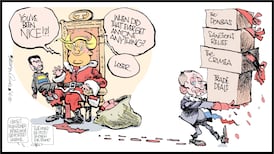The health of Irish democracy demands that Fianna Fáil and Fine Gael TDs get over the panic induced by last weekend’s shock election result and begin to assess their options in a calm and considered manner.While there is no escaping the stunning rebuff suffered by both parties, the outcome needs to be put in context.
Yes Sinn Féin did end up with a bigger share of the vote than any other party and if it had run more candidates it would probably have the biggest number of seats as well. This has changed the political landscape in a fundamental way but it does not mean that Sinn Féin has an automatic entitlement to be in government.
The party’s share of the vote was an impressive 24.5 per cent and if the votes won by the various hard-left factions are added to that, it can be argued that about 30 per cent of the electorate voted for a radical left-wing government with an aggressive nationalist agenda.
Both parties have suffered a loss but that is no reason to walk off the pitch and hand power to people they believe will wreck the economy and damage our international standing
The converse of that is that about 70 per cent of the electorate voted for no such thing. Why has the narrative taken hold that a minority of the electorate has the right to impose its will on the majority? It is akin to saying that Jeremy Corbyn’s Labour Party with 32 per cent of the vote in the recent British election has a right to be in government.
Actually, the combined Fianna Fáil and Fine Gael vote at 43 per cent is exactly the share of the vote that gave the British Conservative Party a resounding victory. While our political culture and voting systems are quite different, those basic facts have to be borne in mind when considering what should happen next.
Economic issues
For a start, the policy differences between Fine Gael and Fianna Fáil on fundamental economic issues are minimal and amount to differences of emphasis more than anything else. Even a cursory analysis of their election manifestos shows how close they are.
That is why, for all its faults, the confidence-and-supply arrangement between the two parties worked for four years. Both parties have suffered a loss of seats but that is no reason to walk off the pitch and hand power to people they believe will wreck the economy and damage our international standing.
A number of Fine Gael TDs have been talking loudly about the need to go into opposition to rebuild the party and this has been echoed by some in Fianna Fáil who want to remain in opposition for the same reason.
The second option is the most feasible but it would require all parties involved to make important concessions
While this mood is understandable in the light of the election shock, giving in to it would represent an unforgivable failure of nerve at a critical time in our history.
Of course opposition looks like an attractive option to politicians who have suffered a severe rebuff for having done what most outside observers would regard as a reasonably good job running the country for the past four years but walking away from their responsibilities would be far worse.
Fianna Fáil leader Micheál Martin has shown political grit in the face of a deeply disappointing result by refusing to row back on his rejection of Sinn Féin as a coalition partner. Assuming he can bring the party with him, he has two basic options. He can try and win the support of the Greens, Labour, Social Democrats and an array of Independents to be elected taoiseach and attempt to cobble a government together.
Fresh thinking
Alternatively, he can strike a deal with Fine Gael and try to bring the Greens along to provide a government with a clear working majority along with an injection of fresh thinking to reflect the desire of a significant portion of the electorate for change.
The problem with the first option is that Labour and the Social Democrats are reluctant to go into government and, while they might be prepared to support it from the outside, the chances of it lasting for very long are limited.
The second option is the most feasible but it would require all parties involved to make important concessions. Fine Gael would have to drop the notion of a rotating taoiseach and accept that Martin would hold the office for however long the agreement lasted. The Greens would have to make a big leap of faith in trusting the two other parties to deliver significant elements of the climate change agenda.
Still, such a government would have a clear majority and if it came into office with bold new policies to tackle the housing crisis and reform the health service, as well as climate change, it could argue that it was responding to the mood for change. The coming together of the two Civil War parties would represent fundamental change in any case.
The main objection both parties have is that it would allow Sinn Féin to build even further in opposition and be in a position to come to power with its left-wing allies after the next election. That is a risk worth taking given that the future is impossible to predict and in any case if a majority of voters opt to elect Sinn Féin on a socialist/nationalist platform there will be no arguing with their mandate. Until it happens, though, the parties representing majority opinion have a duty to work together.









